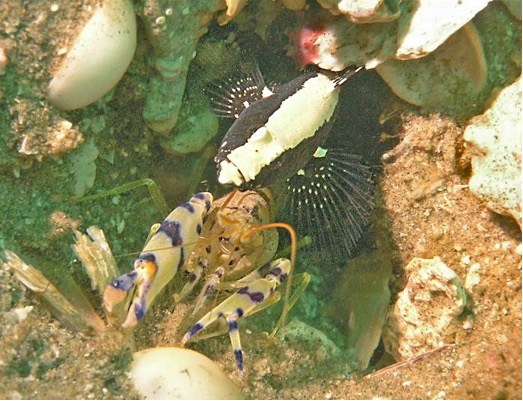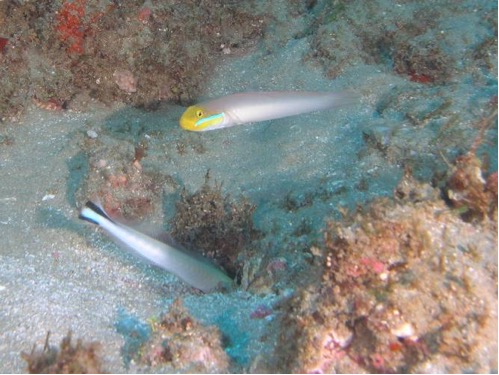News
Construction Crews – who digs those holes in the sand?

Gliders, Mantis Shrimps and Gorgeous Prawns… Mouth filled with sand, the Pennant Glider emerged from his hole and expelled the sand onto the growing pile at the edge of the hole. His partner darted into the hole and emerged with another mouthful of sand that he too spat onto the pile. Their burrow was formed in a crevice in the sandy rubble bottom and they had simply taken up residence in it and kept it clear. But the varying currents kept filling it, shells rolled into it, and they maintained it by suction and jet expulsion. This simple method of clearing a hole is used by many fish species as a sort of undersea vacuum cleaning system.

Not all such undersea residences are natural however. Some of the most impressive burrows on the reef are made by the Mantis Shrimp. They have immensely powerful front claws, and some species are able to break a camera lens with a blow. They can easily dig out a substantial hole in the sand on the reef, and Mantis shrimp are largely responsible for the more impressive holes on the reef.
The Giant Mantis creates a fully lined, superbly constructed burrow for himself in soft sand. These holes seem to be lined with a cement made with spittle and bits of sea-grass, and they are extremely strongly built.

Smaller holes become the home of Commensual Partnerships between a prawn and a goby.
The Goby can see and hunt but can’t dig, and the prawn can dig but is blind and can’t hunt. So they team up, and form a mutually beneficial relationship.
The goby’s task is to find food, and the prawn shares his bounty. The goby acts as the attack alarm, and is incredibly sensitive to movement and light. Few people know to wait and watch their interaction but it can be hilarious.

The prawn’s job is to dig and shovel the debris out of their home as it accumulates, depositing it in the right place by following the spine of the Goby with a feeler. The goby moves to point in the direction where the prawn must shovel the next pile of sand. This works very well until an extra goby arrives, or another shrimp joins the team.
We watched for half an hour as a pair of industrious shrimp both shovelled sand, small coral pieces and bits of shell out of the hole under the direction of a rather harassed-looking goby. The problem came when they both shoved at the same long coral piece, and it got stuck in the mouth of the hole. Looking baffled, his line of retreat closed, the goby darted off and hid under a rock. The two prawns shoved vigorously until the mouth of the hole ruptured, and a full day’s work dropped back into the hole. The goby came home, and you almost hear him muttering with rage as he haughtily dived through the debris to seek sanctuary below.

Where there are two gobies and only one shrimp sharing a hole, it is even funnier, as the two gobies point the prawn in opposite directions. We watched a completely paranoid prawn shoving a pile of sand and shells out of the hole as directed by the first goby and then pushing the same pile of sand back into the hole by following the spine of the second goby. The hole never changed, and we left before the prawn gave up.
Look out for holes in quiet corners on rubble or sandy bottoms, duck behind a rock, and watch. It’s worth it.
Words: Jill Holloway
Pics: David Holloway
Copyright: Ocean Spirit
Gear News
Introducing the TR-80, IR-50 and CS-30 Regulators from DYNAMICNORD

Whether you are a beginner or a professional diver – with the three new main regulators from DYNAMICNORD, everyone will find their favourite regulator. They all look super stylish.
Excellent performance with the TR-80
Quality and performance are the be-all and end-all for regulators. It is not for nothing that the TR stands for Tec Reg. The innovative design of the TR-80 guarantees absolute reliability – even in ice-cold waters.

Perfect breathing effort at 0.8 J/l / certified for diving in waters below 10 degrees / structural design made of solid brass for best cold protection / membrane-compensated design with dry seal of the first stage / reduced exhalation effort thanks to optimized exhalation membrane and bubble deflector / adjustable Venturi (dive/predive) and adjustment knob for individual inhalation comfort / innovative design of the front cover prevents free-flow in strong currents or when diving with scooters / design made of sandblasted brass, matt chrome finish / 2 HP and 4 LP outlets / mouthpiece made of high-quality, anti-allergic silicone for maximum comfort.


Amazing underwater adventures with the IR-50
The IR-50 is the top regulator for advanced and experienced divers. Natural breathing is the essence of this regulator.

Ideal breathing effort at 0.8 J/l /certified for diving in waters below 10 degrees / compensated membrane / adjustable venturi (dive/predive) and adjustment knob for individual inhalation comfort/ outlet valve and deflector for minimum exhalation effort and reduction of bubbles on the face / design made of sandblasted brass, matt chrome finish / 2 HP and 4 NP outlets / mouthpiece made of high-quality, anti-allergic silicone for maximum comfort.


The Workhorse – our CS-30
For diving centres and diving beginners – the workhorse stands for strong construction, reliability and robustness. Perfect for your training.

Optimal breathing effort at 0.8 J/l /recommended for diving in waters above 10 degrees / non-compensated piston / adjustable venturi (dive/predive) / outlet valve and deflector for minimum exhalation effort and reduction of bubbles on the face / design made of sandblasted brass, matt chrome finish / 1 HP and 3 NP outlets / mouthpiece made of high-quality, anti-allergic silicone for maximum comfort.


Octopus OP-30
The OP-30 is the ideal addition to all DYNAMICNORD regulators. It is identical in construction to the CS-30.

The TR-80, IR-50, CS-30 (DIN & INT) regulators and the Octopus OP-30 are available from DYNAMICNORD dealers and in the online store.
DYNAMICNORD – Your Outdoor Companion.
Marine Life & Conservation
Paul Watson Released as Denmark Blocks Japan’s Extradition Bid

Renowned anti-whaling activist Paul Watson has been released from custody in Greenland after spending five months in detention. Denmark’s Justice Ministry rejected Japan’s request for his extradition, citing insufficient guarantees that his time already served in custody would be credited against any potential sentence.
The 74-year-old Canadian-American was arrested on July 21 in Nuuk, Greenland’s capital, when his ship docked to refuel. His arrest was based on a 2012 Japanese warrant related to a 2010 encounter in Antarctic waters. Japan alleged Watson obstructed operations and caused damage to a whaling research ship during efforts to disrupt illegal whaling. Watson has consistently denied these claims, maintaining his commitment to marine conservation.
Denmark, which oversees extradition matters for Greenland, concluded that while the legal conditions for extradition were met, the lack of assurances from Japan regarding time-served credit made extradition untenable.
In a video shared by his foundation, Watson expressed gratitude and relief, saying, “After five months, it’s good to be out… and good to know they’re not sending me to Japan.” He added that the most difficult part of his time in custody was being separated from his two young sons.
Watson is a pioneering figure in marine conservation, known for founding the Captain Paul Watson Foundation in 2022 after decades of activism with the Sea Shepherd Conservation Society. His bold efforts to defend marine life have earned him widespread support, including from celebrities and conservationists. His work has also been featured in the acclaimed reality TV series Whale Wars.
Watson’s lawyer, Jonas Christoffersen, praised the decision, stating, “We are happy and relieved that Paul Watson is now free.” He added that Watson is eager to reunite with his family and continue his vital work.
The arrest occurred while Watson’s vessel, the M/Y John Paul DeJoria, was en route to the North Pacific with a team of 26 volunteers to intercept a Japanese whaling ship. His foundation described the arrest as politically motivated and emphasized that Watson’s actions were focused on ending illegal whaling practices.
Japan resumed commercial whaling in 2019 after leaving the International Whaling Commission, asserting that whale meat is a cultural tradition. Conservationists, however, continue to challenge these practices, highlighting their impact on marine ecosystems.
Despite the challenges, Watson remains steadfast in his mission to protect marine life and bring attention to whaling practices. His dedication to ocean conservation has made him a globally respected advocate for the environment.
-

 News2 months ago
News2 months agoIconic SS United States to become the World’s Largest Artificial Reef
-

 News3 months ago
News3 months agoBook Review – 52 Assignments: Underwater Photography
-

 Gear News3 months ago
Gear News3 months agoDYNAMICNORD – New German diving brand enters the British market
-

 News3 months ago
News3 months agoExploring Cenote El Pit: A Diver’s Dream
-

 Gear News3 months ago
Gear News3 months agoTry BARE drysuits (and maybe even win one!) this Friday with Sea & Sea at North West Dive Fest
-

 Marine Life & Conservation3 months ago
Marine Life & Conservation3 months agoBook Review: Coral Triangle Cameos
-

 Blogs2 months ago
Blogs2 months agoDive the Egyptian Red Sea this Autumn with Regaldive
-

 News3 months ago
News3 months ago2024 Ocean Art Underwater Photo Competition Announced















